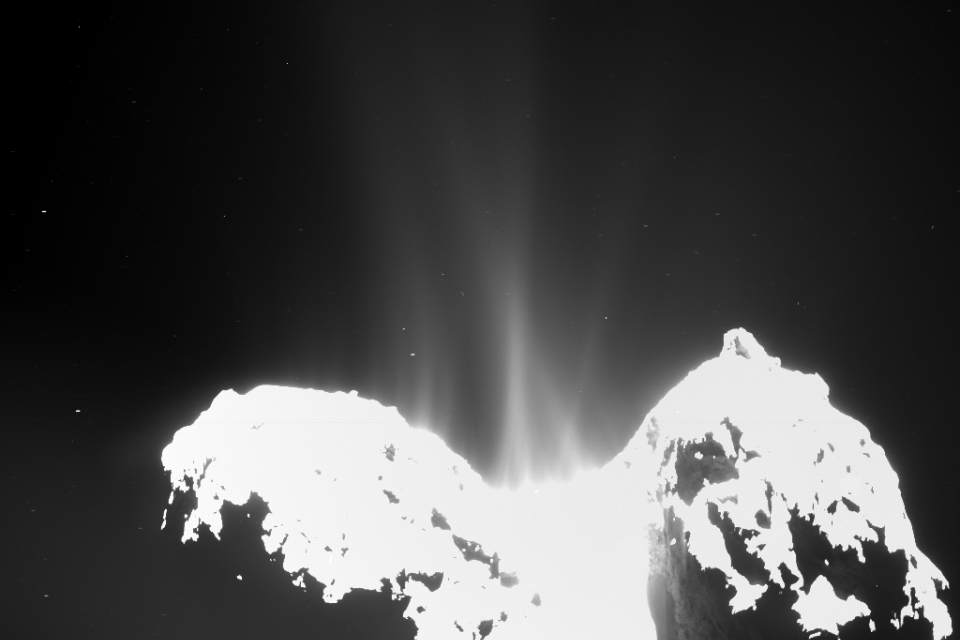Jets of activity
OSIRIS images of Rosetta’s comet show spectacular streams of dust emitted into space.

This overexposed image (exposure time of 18.45 seconds) shows the jets arising from the comet’s surface. The images were obtained by the wide-angle camera of OSIRIS, Rosetta’s scientific imaging system, on 20 October, 2014 from a distance of 7.2 kilometers from the surface. Credit: ESA/Rosetta/MPS for OSIRIS Team MPS/UPD/LAM/IAA/SSO/INTA/UPM/DASP/IDA.
Rosetta’s comet 67P/Churyumov-Gerasimenko is beginning to show a clearly visible increase in activity. While in the past months most of the dust emitted from the body’s surface seemed to originate from the neck region which connects the two lobes, images obtained by Rosetta’s scientific imaging system OSIRIS now show jets of dust along almost the whole body of the comet.
Currently, still more than 450 million kilometers are separating 67P from the Sun. Based on a rich history of ground-based observations scientists expect a comet’s activity to pick-up noticeably once it comes within 300 million kilometers of the Sun.
While 67P’s overall activity is clearly increasing, the mission’s designated landing site on the “head” of the comet still seems to be rather quiet. However, there is some indication that new active areas are waking up about one kilometer from landing area J. These will allow the lander’s instruments to study the comet’s activity from an even closer distance.

In this image taken by OSIRIS, Rosetta’s onboard scientific imaging system, on 10 September, 2014 jets of cometary activity can be seen along almost the whole body of the comet. Credit: ESA/Rosetta/MPS for OSIRIS Team MPS/UPD/LAM/IAA/SSO/ INTA/UPM/DASP/IDA.
Rosetta and the UK
With funding from the UK Space Agency and the Science and Technology Facilities Council (STFC), Rosetta is a mission with significant UK involvement from industry and science.
One of the main challenges for all the companies designing instruments for Rosetta has been to ensure the components remain intact for ten years, while the spacecraft makes its way to the comet, and then work perfectly when it gets there. Not an easy task! Visit the UK Rosetta website for more information about the UK’s involvement.
Industry involvement
- Airbus Defence and Space, based in Stevenage, was the major subcontractor for the Rosetta platform
- e2v, based in Chelmsford, designed and supplied the high performance imaging devices used in the Navigation Camera, OSIRIS narrow field and wide field cameras and VITRIS-M instruments on the orbiter and ROLIS and CIVA instruments on the lander
- ABSL Space Products provided innovative batteries for the spacecraft and lander
- these are smaller, lighter and much more reliable than the traditional nickel-cadmium batteries
- ERS Technology supported the development of many subsystems including the reactions wheels, solar array drive motors, Philae harpoon motors and developed the lubricant for the atomic force microscope on the Micro-Imaging Dust Analysis System (MIDAS)
- Technology created by CGI Group helped to explore some of the issues involved in such a long mission
- the company was also involved in the development of the Rosetta on board software
- moog provided tanks to store the helium used by the lander.
- STFC’s RAL Space co-developed the Ptolemy instrument with the Open University and designed the thermal insulation for the GIADA and VIRTIS instruments as well as the Philae lander itself
- SciSys UK Ltd is responsible for the spacecraft Mission Control System development and maintenance. In recognition of this work on the Rosetta and the Beagle 2 missions, SciSys were awarded the title of “Innovator of the Year” by the UK Computing Awards for Excellence 2004
- Surrey Satellite Technology Limited (SSTL) designed a wheel that will stabilise the probe as it descends and lands on the comet
- Telespazio VEGA was involved in many aspects of the Rosetta mission, from the overall design of the spacecraft to the on-board software
Science involvement
UK scientists are involved in ten of the 21 experiments that Rosetta will carry out during its mission:
- the Open University in collaboration with STFC RAL Space designed and built the Ptolemy instrument on the lander and is contributing scientific expertise to the GIADA, MUPUS and SESAME instrument teams
- the University of Kent will be helping to analyse the results from the OSIRIS instrument and have been involved in observing Rosetta’s target comet from ground-based telescopes to aid mission planning
- Imperial College London and University College London’s Mullard Space Science Laboratory (MSSL) supply the team studying the comet’s plasma
- Scientists at Oxford University are part of the science team for VIRTIS
- Queen Mary College at the University of London will be investigating the results of the CONSERT instrument
- Researchers from Queen’s University Belfast are part of the team observing Rosetta’s target comet using ground-based telescopes